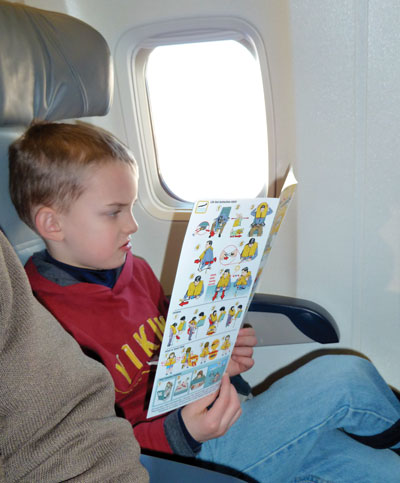
flying solo
Sending kids into the friendly skies
By Erin Kirkland
When Rachel McGovern first flew from Anchorage to Juneau at age 7, she carefully packed a bag of snacks, love notes from her parents and enough books to last the 90-minute trip. With hardly a backward glance, she marched on board with a flight attendant, settled in a seat and was delivered to her grandparents’ waiting arms a short time later, cool as a cucumber. But is it always this simple and seamless?
Few things cause more hand-wringing among parents than images of children disappearing behind the door of an airplane set to travel at 30,000 feet. No matter how many hours of preparation precede the big day, flying without a grownup represents a major step in independence for both kids and parents.
Flying Alone:
Tips for smooth travel
Review individual airlines’ policies and procedures for children flying alone; some will allow online booking, some require a telephone purchase. In any case, an additional cost will be required, ranging from $50-$75, and do expect to fill out extensive paperwork with names, phone numbers and an emergency contact for both the city of origin and final destination. Alaska Airlines has excellent tips on their website, alaskaair.com/content/travel-info/policies/children-traveling-alone.aspx. If possible, fill out all forms prior to arriving at the airport.
Stage an age-appropriate rehearsal. Younger children might enjoy a role-playing scenario with parents as flight attendants. Walk-through a mock security area, pretend to board the plane and fasten seat belts. Talk about odd noises as airplanes warm up, take off and land. Older kids might benefit from a trip to the airport to watch ticketing agents, baggage claim and security officials at work.
Arrive at the airport two hours before departure to fill out remaining paperwork, check-in and meet gate agents. Up to two adults, and any minors under 21, may secure a “gate pass” for escorting an unaccompanied minor to the departure area or to meet an incoming flight. Plan to remain in the gate area until the aircraft has taxied to the runway; a requirement of airlines.
Pack comfort items with youngsters; snacks, favorite books, quiet toys, or apps on a mobile device. Some parents add photos of family members or little gifts to deliver upon arrival.
Check weather at the destination city using www.weather.gov, and be aware that inclement weather delays may influence your child’s ability to fly alone. Refer to individual airlines for cancellation policies.
Bring government-issued ID, and remind those in the destination city to bring theirs, too. Airline representatives will not release a child to anyone without it, no matter the relationship.
Know your air carrier
Most airlines consider children under the age of 15 “unaccompanied minors” if flying in the absence of an adult, according to AirConsumer.dot.gov, a federal-run website dedicated to all things air travel. Age is but one factor in a long list of requirements, and individual air carriers have the right to establish their own policies for who, and where, unaccompanied minors may travel, including without an escort.
Tim Thompson, public affairs manager for Alaska Airlines, says the Seattle-based company works hard to make sure young travelers feel safe aboard their flight.
“Our customer service agents are in tune with the comfort levels of children flying alone,” he says. “We gladly escort kids to their final destination, and our customer service agents are trained to ensure the safety of each child.”
Know your child
Air travel has certainly changed since the days when parents shepherded children aboard airplanes, then presented flight attendants with directions related to manners and soda consumption. The events of September 11, 2001 changed air travel for everyone, says Thompson, including unaccompanied minors. “Prior to 9-11, there were no limits to the number of family and friends who could escort a child to the gate and on the plane,” Thompson says. “Security is definitely the main factor now.”
With so much external attention placed on safety, some kids worry during every step of the process and don’t relax until safely home again, but others, like Rachel, take things in stride. The key is small steps and taking cues from the child, regardless of age.
Rachel’s mother, Jennifer, walked her daughter through the Anchorage airport as soon as flight arrangements were made, talking about security, her escort from Alaska Airlines, and what would happen once she got on board the aircraft.
“Even though it was required by the airline, I also made sure Rachel knew I’d be in the gate area until her plane took off, and talked with flight attendants before she boarded,” Jennifer says. “She felt better knowing I was aware of who was taking care of her.”
Know your flight crew
Flight attendants play a leading role in the supervision of unaccompanied minors. Melanie Rush, a flight attendant and mom, advocates the extra minutes for one-on-one conversation, getting to know young charges and explaining reasons behind the compulsory safety speech.
“I show kids how to open and buckle their seatbelt, how to find the closest exit and pay extra attention to who their seat mate is. I also make sure to check on them throughout the entire flight,” she says.
Rush’s chief recommendation? “Allow lots and lots of time,” she says. “Time to use the bathroom, time to grab a snack and time to meet us before boarding. It’s so much easier when everyone is calm and relaxed.”
Have a pleasant flight, kids, and don’t worry about your parents. They’ll be fine.
Flight attendants play a leading role in the supervision of unaccompanied minors










